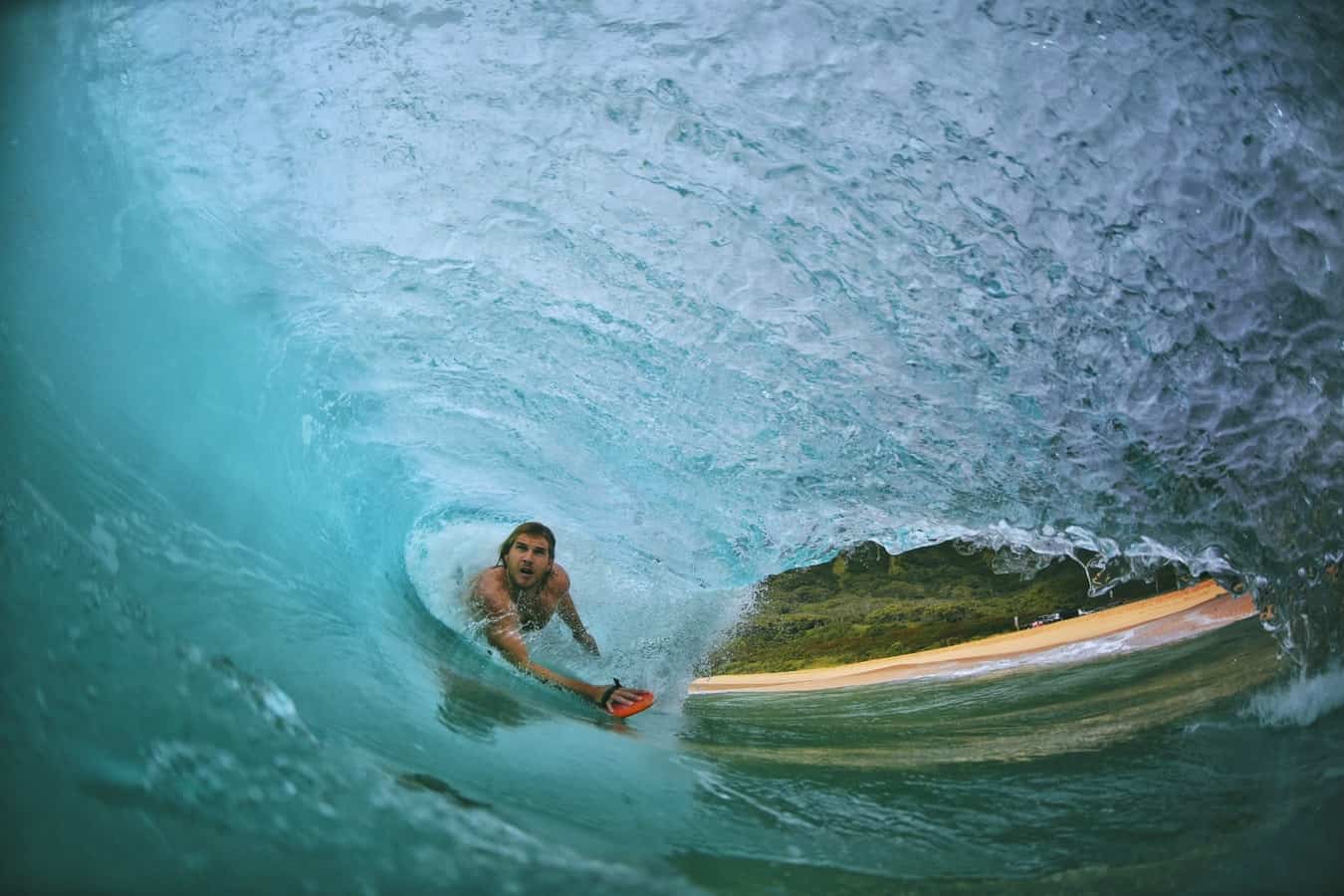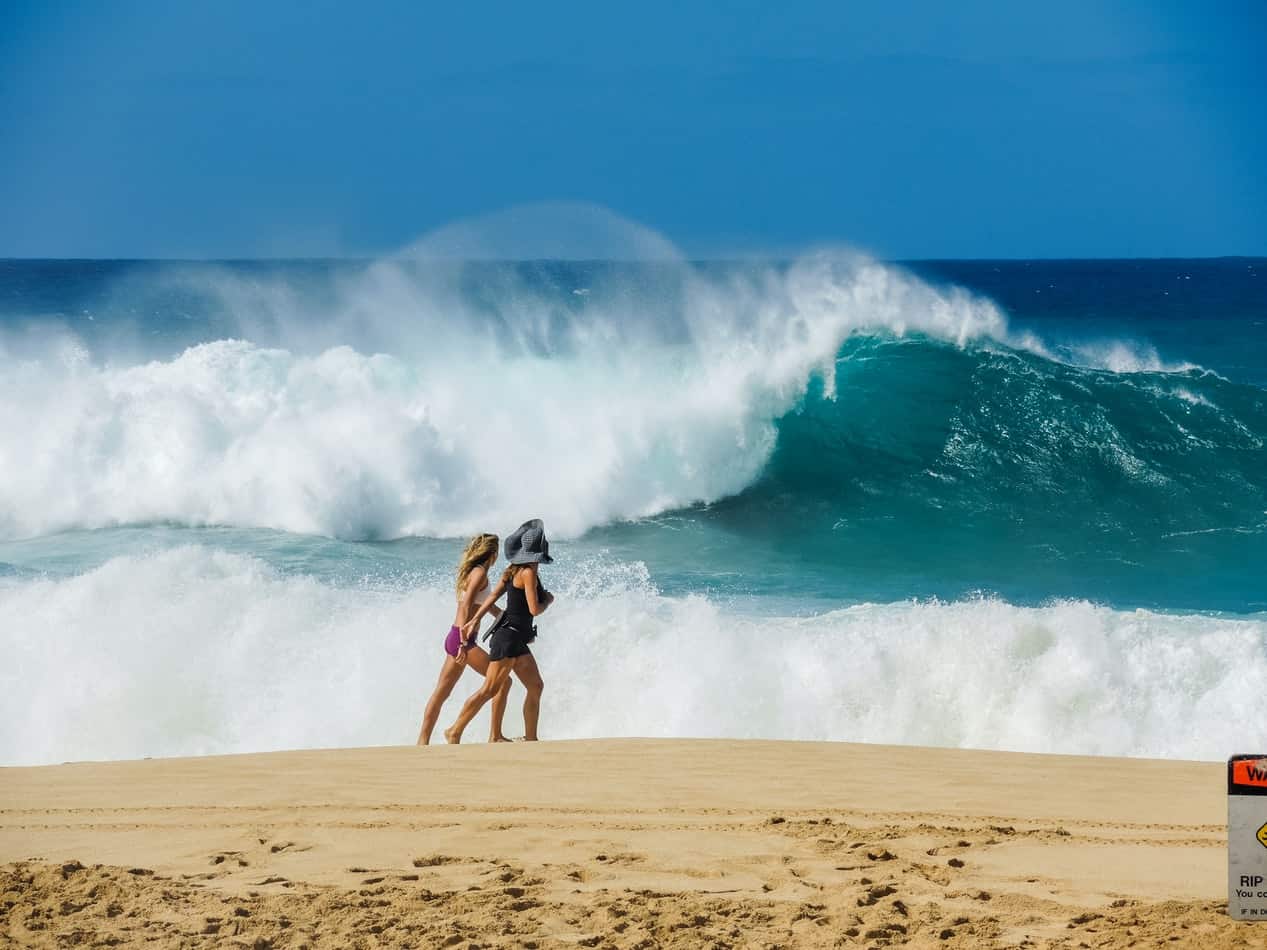We surf waves of all different sizes, in both high tide and low tide. A wave pulls up the water below and builds until we surf to the edge of the wave. If we wipeout, the force of the wave pushes us down into the water after it breaks. We go under close to the bottom and safely return to the surface. However, there are some waves that surfers should never ride. One kind of wave to avoid is called a shore wave.
What is a dangerous shore break? A shore break is when a wave breaks directly onshore. Shore breaks occur when there is a rapid change in the ocean from deep to shallow water.
You should never ride a shore break because you are risking getting a serious injury. The phenomenon of a shore break can be watched in wonder as powerful waves break only a few feet from the beach. But don’t ever try riding a shore break.
Ocean swells travel through the deepest water and remain intact. Once the swells come by shallower water near the shore, they break as waves do. Shore breaks happen, then, when there is a sharp, abrupt change in the depth of the water. Since ocean swells maintain their great force, the swells unleash an incredible amount of energy when they convert to waves near the shoreline, where the water is shallow.
Why Is A Shore Break Dangerous To Surf?
A swell in the ocean is formed by wind conditions. If the wind is strong and it has a long duration, a swell develops. It gathers more and more strength over time and distance as the energy builds up beneath the surface of the water. The deeper subsurface waves that develop are known as “swells.”
The shallow water causes them to turn into waves above the surface where all their energy is unleashed. A surfer riding a swell near the shoreline (also known as a shore break), will crash either at the shallow sea bottom or on the shoreline.
The shore breaks have much more power than exceptionally large waves, barrel waves, and of serious injury, but because these waves last only a second or two before they break. When they do break, it thrusts the surfer under the water to the bottom, and the bottom can be only a couple of feet deep or even less.
What Kinds Of Injuries Do Surfers Get From Riding Shore Breaks?
Some shore breaks seem harmless, only a few feet in height. However, even a 1-foot shore break harnesses the power to break bones, keep surfers and swimmers pinned to the sea bed, and on the shore, they can wash beachgoers sitting nearby off the shoreline and into the surf. This is especially dangerous if there are children nearby.
Shore breaks can pull you out in the ocean where the water can be more than 15 feet deep. If you become caught in a rip current, you need to keep a clear head and swim swiftly back to shore.
Most surfers who attempt to ride shore breaks will sustain back and neck injuries. These injuries happen when the powerful break thirsts the surfer head first to the ocean bottom.
Shore breaks often occur, besides beaches with a soft sea bed, near rock formations or a rocky sea bed bottom. When thrown headfirst into the water, they hit their heads on rocks and either go unconscious or sustain serious spinal cord injury.
Shore breaks are unpredictable. One moment they are causally rising into big waves, only to turn dangerous and break rapidly and with great force. The injuries they cause affects the head, the neck, the shoulders, the spinal cord, the ribs. Some spinal cord injuries are so severe that they are life-threatening.
The worst possible injury, if one survives it, is a spinal cord injury from riding shore breaks. Even professionals aren’t meant to ride these waves, nor do they ever try because they know how dangerous they are.
When a surfer’s spinal cord is injured because his head hits the sea bottom, the spinal cord can break at the neck, causing death almost instantly. The worst outcome of injury from riding shore breaks is lifelong paralysis from a severe injury to the spinal cord.
In the worst situations, people have become paraplegics and quadriplegics and must spend the rest of their lives in wheelchairs, some not able to perform basic functions without assistance.
Lifeguards have reported cases of seeing a lifeless-looking body floating in the water. The lifeguard ran into the surf and pulled the person out, only to find that the man is awake and alert, but he cannot move his body. The surfer is paralyzed for life, and the lifeguard calls an ambulance for the unfortunate man or woman to be taken to the hospital. Had the lifeguard not seen the body, the man would likely have drowned because he was no longer able to swim.
Lifeguards are exactly that: they protect the lives of everyone in the ocean. I teach surfing and often call over a lifeguard during group lessons to talk to the new surfers of the dangers in the ocean.
Neither I nor any lifeguard wishes to discourage anyone from surfing. Surfing is one of the most amazing sports in the world, and surfers fall in love with the ocean and establish a personal relationship with it.
But there are dangers in the water, and shore breaks are perhaps the worst of all since the waves that develop from swells look so innocent and inviting to ride – until it throws you down head first onto the shallow sea floor.

What Other Ocean Hazards Should Surfers Stay Away From?
- Rip Currents can sneak up on you while you are in the ocean having a good time. You look to shore and notice you are much further out than you thought. You try swimming to shore but you’re not making forward progress. You’ve been caught in a rip current, also referred to as a riptide.
To get out of the current, swim parallel to the shoreline. Swim to the end of the current, move in a little, then double back, swimming parallel to the shore in the opposite direction. Swim to the end of the other side of the current and move closer again. Repeat until you are completely out of the rip current’s pull.
- Avoid Surfing Near rocks And Piers, especially if you’re new to surfing. Point breaks occur near land masses that jut out into the water, and these masses can be formed from rock. Although tempting to surf, only the most experienced surfers should try riding point break waves.
What’s even worse is that where there are visible rocks, there are also rocks under the surface of the water. You can be paddling when a sudden wave hits you and flips you over on your surfboard.
The behavior of the waves is quite different near rocks and piers. The form o the wave is erotic and unpredictable. Rocks or piers that go far out into the ocean can cause rips in the water, flinging you in all directions. If you’re experienced at surfing, proceed with great caution. If you’re a beginner surfer, don’t’ do it. Period.
- Don’t Surf For A Day Or Two After Rainfall. Some of the best places to surf are near heavily populated urban areas. When it rains, there is runoff from the urban zone that goes directly into the ocean. This includes untreated trash, animal and human waste, plastics, oil, and other pollutants
Waste in the ocean is an unfortunate fact of life today. Much of what we consume ends up in the ocean in the form of bottles, garbage, and feces. The water is polluted, but it’s even worse after rainfall.
These waste products can cause infections to the intestines, and if there are open cuts or wounds on the body, skin infections can result.
Related Questions
Are Some Shore Break Waves Okay to Surf On?
There are no surfer-friendly shore break waves. This is because the power and the thrust force of these waves are unknown until one throws an unwitting surfer down to the bottom. The problem is that most surf break waves do not look threatening at all, so it’s hard to tell the difference between safe waves and dangerous ones.
How Do I Know When It’s Safe To Surf?
If you are near the beach, you can speak to a lifeguard about ocean conditions. Look for signs that inform you that it’s dangerous to surf. The signs read like “Warning. Dangerous Shore Break. Waves break in shallow water. Serious injury can occur.”
You can also check surf conditions with the National Weather Service in your area for beach conditions at their website.
Where Are The Most Dangerous Places To Surf?
One of the worst places in the world where shore breaks occur is in Hawaii. Places like Waimea Bay off Oahu not only have some of the most dangerous shore breaks, gigantic waves build to a height over 25 feet and come at you suddenly, causing the death of famous surfers, like pro surfer Donnie Solomon.
Puerto Escondido has claimed the lives not only of surfers but of tourists swimming in the water, only to see a wall of water coming to crash down on them. The appeal of Puerto Escondido to surfers is the challenge of riding gigantic waves, and the knowledge that there is soft sea sand underneath. But the waves can be silent and deadly, throwing surfers down with enough force to snap their necks.

